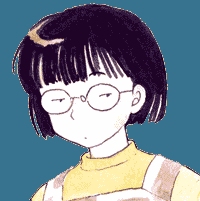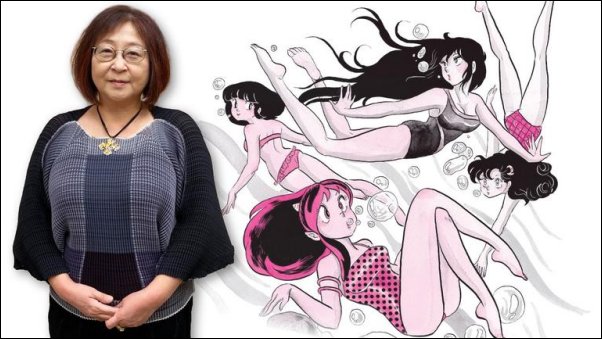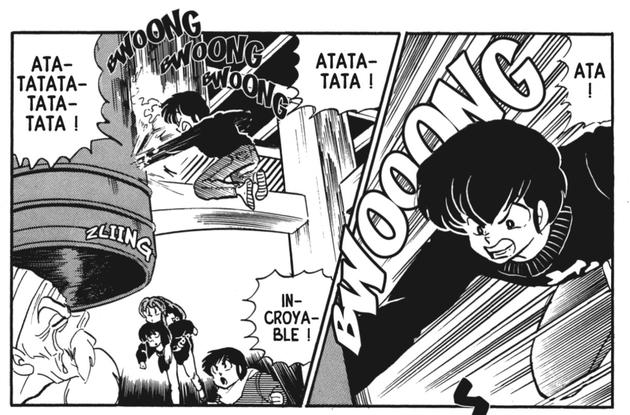

Rumiko Takahashi: "I Live and Breathe Manga"
Translation by: Dylan Acres
INTERVIEW - The queen of manga, grand prize winner of the Angoulême Festival in 2019, opened the door to her universe in Tokyo. Meeting with a special author, who has spanned several generations.
By Valentin Paquot Published on January 27, 2020 at 23:00, updated on January 28, 2020 at 08:53

Rumiko Takahashi- Her name resonates with deference among all fans of Japanese art. It wasn't really a surprise to see her consecrated in the 2019 Angoulême Grand Prix. It is more surprising, however, to have the opportunity to interview her (here, thanks to Glenat editions, publisher in France of the two flagship titles Urusei Yatsura and Ranma 1/2). The manga queen prefers to write new stories than tell her own.
With a sparkling eye, Rumiko Takahashi asks as many questions as she gives answers. She has an insatiable curiosity. We understand why her imagination seems endless. For her, life is a source of inspiration. Very early on, she knew she was going to become a mangaka. Daughter of a doctor, the youngest of the family, she learned drawing from the Indian ink paintings of her father. [1] At twelve, she bought her first pencils and drew yon-koma (manga with four-panels, equivalent to a comic strip). Before entering college, she already submitted manga to the magazines Shonen Sunday and Garo (where Susumu Katsumata, of whom she was a fan, was a member). [2]
What made you want to become a mangaka?
Takahashi: As a child, I read a lot of manga. You could say that I was bathed in it. So it was done very naturally. It wasn't a revelation or a shock, my goal became more obvious as I read more.

You often include references to other manga in your work...
Takahashi: It's something I used to do frequently when I was young and a little less so these days. Generally speaking, what interests me is to cite idioms that are recognizable by all. Passages that are familiar to the readers. I like to appeal to the reader via the general culture linked to manga.
What are your main influences?
Takahashi: More than a work, I prefer to cite the following authors who are essential people in the world of manga: Osamu Tezuka, Fujio Akatsuka and Fujiko Fujio. [3] These are the biggest influences I've had.Are you aware that you too have become so influential with young authors?
Takahashi: I am unable to place myself on the same level as the three authors I mentioned. They are gods of the manga world. I'm just happy to be in the same world as them, to be able to work as a mangaka."I love to draw and invent stories: by the same token I work without having the impression of working." -Rumiko Takahashi
You have a reputation for always delivering your stories on time. What is your secret?
Takahashi: Above all, it should be noted that manga is an integral part of my life. I live and breathe manga. My daily life is punctuated by manga. It's my top priority. Also, I love to draw and invent stories: by the same token I work without it feeling like work, without having to force myself in any way. I respect deadlines, in a way, without doing it on purpose.Describe your typical week...
The first three days, I work alone on the storyboard. Once finished, I call my editor to discuss it. [4] As I work in the evening, my editor comes around 11 p.m. and approves the storyboard or gives me feedback. Then I work until morning, and I sleep in the middle of the day. Then there are two days dedicated to inking and finishing on the roughs. This is the time when my assistants come to the studio. They usually arrive around 8 p.m. and we work until the early hours. I'm the only one working on the characters. I take care of it during the day, before the assistants arrive. They take care of the solid colors, the decorations and part of the inking.
You essentially create romantic comedies. Do you prefer comedy or romance?
Takahashi: Even when I make serious stories, I integrate notions of love and romance. So if I really have to choose between love and comedy, it would be love. But both seem essential to me.You are a fan of Shinji Mizushima and his Abu-san (a manga series on baseball) but also of Mitsuru Adachi. What do you particularly like about their works?
Takahashi: Mizushima-sensei is one of the pioneers of manga in baseball and even in sports in general. I even wonder if I did not discover baseball through his manga before seeing it on television. What I like about his work are the characters he develops and the richness of the universe he builds around them. In the case of Adachi-sensei, I really like the softness of his characters and the universe he creates, from a graphic as well as a logical point of view. He also has an incredible talent for managing time and rhythm. I have great esteem for both of these authors. [5]
Lum was supposed to only appear for a chapter, but imposed herself to become the protagonist at Ataru's expense. How did that happen?
Takahashi: In reality, in the full story, she should have only appeared in the first five chapters. We had imagined the content of five chapters with my editor. [6] In the first chapter, I made Lum appear, in the second chapter it was a completely different story, but in the third chapter I found myself having to involve Lum for my story to succeed. I then realized that it worked well so I saved her for the fourth and fifth chapters. At that time, my publisher told me that the readers liked this character and that it would be good to keep her for the future. She ended up becoming the heroine of the manga.
Created in the 1980s, the history of Maison Ikkoku continues today. Beyond the timelessness of a romance, why does this work remain so enduring?
Takahashi: Maison Ikkoku is a work with a strong romantic character, this title evokes one-sided love, the expectation that one can have while being in love, silences and disappointments linked to the heart. It is in these aspects that it is universal and timeless in my opinion.
You made Inuyasha with the idea of making an action, adventure manga. Why?
Takahashi: In fact, I wanted to do an adventure manga, with scenes of strong action. I wanted there to be fights with swords. Probably because my two previous manga, Ranma 1/2 and Urusei Yatsura, were gag manga... comedies. I wanted to try a different genre.
There are not just two universes that meet in MAO, but also two eras. Why this discrepancy?
Takahashi: It creates a gap that is quite visible and interesting to stage. Why go back a hundred years to the Taisho era (early 20th century)? Quite simply because it's a very busy time for Japan. The great earthquake, an economic crisis, Japan is militarizing and moving towards the Second World War... But it is also a very particular period for us, the Japanese. A period before the militarist period, before those dramas, retains a real charm.How are you able to please several generations of readers?
Takahashi: Whenever I start or end a series, I want to go find a new readership. I'm not necessarily trying to link up with my readers from previous series. By that I mean that I'm not trying to reproduce a story that worked with them just to satisfy them. It is this requirement for renewal that, I think, appeals to new readers.Do you remember a particular fan experience?
Takahashi: When I started out, I had a fairly precise memory. In our studio, we didn't have a photocopier. I went to the local bookstore to make photocopies. And while I was copying my storyboards a little kid saw what I was doing, he pointed at me and said, "Oh it's Lum". It really touched me...Footnotes
- [1] Rumiko Takahashi's father, Mitsuo, was a gynecologist in Niigata. Her father enjoying drawing and in 1989 she published a collection of his sumi-e paintings of kappa which he published under the pen name Utsugi Takahashi (高橋卯木).
- [2] Susumu Katsumata (勝又進) was one of the major figures in Garo (ガロ), the alternative, avant-garde manga magazine published from 1964 to 2002. It was fundamental in the development of the gekiga style of manga. It was known for publishing the work of Ryoichi Ikegami (池上遼一), Shigeru Mizuki (水木しげる), Sanpei Shirato (白土三平), Yoshiharu Tsuge (つげ義春) and many others. Katsumata was known for his manga Red Snow (赤い雪/Akai Yuki).
- [3] Rumiko Takahashi has cited these three artists are her earliest influences a number of times in interviews. Obake no Q-Taro (オバケのQ太郎) and Osomatsu-kun (おそ松くん) are classic manga of the 1960s by Fujiko Fujio (藤子不二雄) and Fujio Akatsuka (赤塚藤雄). Osamu Tezuka (手塚治虫) the "God of Manga" is the creator of Astro Boy (鉄腕アトム/Tetsuwan Atomu), Black Jack (ブラック・ジャック) and dozens of other iconic manga.
- [4] To learn more about Rumiko Takahashi's relationship with her various editors over the decades please see "My Page One".
- [5] Shinji Mizushima (水島新司) is an artist she has mentioned enjoying, though not to the same extent as Ikegami. Mizushima is known for his baseball manga Dokaben (ドカベン) and Abu-san (あぶさん). Takahashi's speaks of Mizushima in this interview and also here. Mitsuru Adachi (あだち充) is the artist most closely associated with Rumiko Takahashi as the two have collaborate on works on occasion (such as My Sweet Sunday and various illustrations). Adachi is famed for his romantic baseball manga such as Touch (タッチ), H2 (エイチ・ツー) and Cross Game (クロスゲーム).
- [6] Urusei Yatsura's early publication history was fairly non-traditional. After the first five chapters were published weekly from August through September of 1978 the sixth chapter was then published in a special issue of Shonen Sunday in October or November. Takahashi then returned in February to continue Urusei Yatsura for approximately ten chapters. This was because Takahashi was still in college at this point in her life. She then returned to Urusei Yatsura through April 1979 before stopping and publishing the five chapter monthly mini-series Dust Spot!! in a special edition of Shonen Sunday. After Dust Spot!! she returned to Urusei Yatsura sporadically until March of 1980 when its continual, regular weekly publication began in earnest. Looking at the publication dates of the chapters in the first two volumes helps clarify this as well as shows that some of the chapters were rearranged from their original publication order.

Le Figaro
|